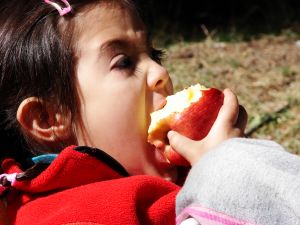By Rita Brhel, managing editor and attachment parenting resource leader (API)
 Kids today are busier than any generation before.
Kids today are busier than any generation before.
School-aged children and teens have ample opportunities to fill their free time with extracurricular activities, and many parents encourage their children to participate in these activities. These activities are fun; they help children find talents and build up skill sets; and they give children additional ways to socialize and make friends. Children as young as early elementary can now participate in myriad activities, from soccer to scouts to theatre.
But parents have to be careful that these fun activities don’t become burdens to their children, that they don’t inadvertently or purposely place their child in a position where the child is feeling pushed to excel in order to gain parental approval, and that they don’t schedule too many activities so that children simply don’t have time to play, relax, connect with others, or just be children.
Rick Wolff, chairman of the Institute for International Sport’s Center for Sports Parenting, spoke in 2005 at the University of Rhode Island about the unreasonable expectations parents can be tempted to place on their children’s athletic futures. His presentation was covered in the article “Parents Pushing Children into Sports a Problem, Growing in Culture” by Meghan Vendettoli, published by the University.
Activities are for Children, Not the Parents
Wolff noted that children want to participate in extracurricular activities because they find them enjoyable, but that some parents see these activities – particularly sports – as a “foundation” for their future, most often in hopes of getting their child a college scholarship. Never mind the fact that less than four percent of high school athletes end up playing collegiate sports.
Wolff was most bothered by the trend of more and more parents pushing their children as young as five or six years old to excel in a sport, at the expense of the child’s happiness.
“A lot of parents don’t get it, and the kids become the victims,” he said.
No Pushing, Please
In the article “Don’t Push Your Children Too Hard in Sports or Other Activities,” published in 2000 on http://healthlink.mcw.edu, Anthony D. Meyer, MD, warns parents of how easy it is to “push” a child into an activity even as they try not to.
“As pre-teenagers, children are completely egocentric, meaning they believe that whatever they do is responsible for what actually happens. If they miss the goal or strike out and the team loses, they believe they are solely at fault,” Meyer wrote. “They also have a very, very strong need to please adults, and a coach or parent who feeds into that need may very easily push a child beyond his or her breaking point.”
How does Meyer advise parents to avoid this pitfall?
“A skillful coach or concerned parent will watch for signs of stress, including difficulty sleeping or eating, total preoccupation with one activity and nothing else, or moodiness,” he said.
If parents fail to recognize these signs, not only will the child grow to dislike the activity but may also become resentful toward his parents. Here are Meyer’s tips to parents to avoid inadvertently pushing their children:
- Get to know your child – Spend time with your child, especially “unconditional time” in which there is no teaching involved. Do whatever the child wants to do, and observe him for 45 minutes. Be open and encouraging, and take delight in what your child enjoys. Learn to empathize with your child.
- Ask the right questions – Is this activity good for your child at this time? Is your child enjoying herself and, perhaps, growing from the experience? Can your child enjoy participating, win or lose? Put what you want for the child out of your mind, and focus on your child’s needs and desires from her level.
- Talk with your spouse or partner – Your spouse may have good insight into how your child is feeling, especially if your spouse’s interests differ from yours; for example, if the wife is interested in volleyball and the husband is interested in choir.
- Help your child find a place in the activity – Not every child is going to excel in the activities they enjoy. For example, a child may enjoy softball but not be very competitive, so instead, the parent can encourage her to serve as the team manager or cheerleader. Show your child that there are many ways they can enjoy an activity, even if she isn’t as talented as her peers.
- Introduce your child to other types of activities – Your child will be drawn toward the activities he enjoys and will be more likely to find his talent. He will also develop a balanced appreciation for many things in life. Children allowed to participate in a variety of activities are able to better handle wins and losses and challenges, and feel that their interests and desires have been recognized.
For More Information
The Sports Parenting Edge by Rick Wolff



